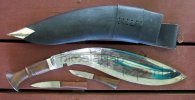- Joined
- Apr 3, 2010
- Messages
- 955
From a website:
Isn't this a folder or small blade steel? That might explain breaking it? I dunno?
440c is an ok steel. Fairly hard and seems to hold up. I think the heat treating is key, seems to be for many companies. Heat treating can be the make or "break" for a blade. I have seen many long blades made of it. Some Condor machete are made of 440c. I have one and it has taken a beat down Ike Turner style.





